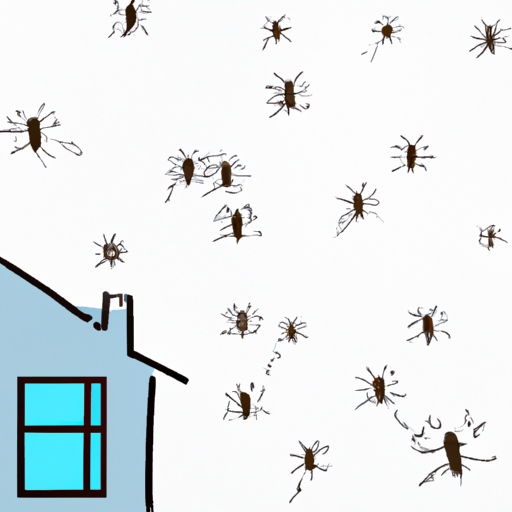Identifying the Common Types of Gnats Found in Homes
Gnats are small, flying insects that can be found in homes. They are often mistaken for fruit flies, but there are several different types of gnats that can be found in the home. The most common types of gnats found in homes include fungus gnats, drain flies, and eye gnats.
Fungus Gnats: Fungus gnats are small black or dark gray insects with long legs and antennae. They feed on decaying organic matter such as plant roots and fungi growing in damp soil or other moist areas around the home. Fungus gnat larvae feed on plant roots and can cause damage to houseplants if left unchecked.
Drain Flies: Drain flies have a moth-like appearance with a fuzzy body and wings covered in tiny hairs. They breed in drains where they lay their eggs which hatch into larvae that feed on organic matter such as hair, grease, soap scum, food particles, etc., which accumulate inside pipes over time.
Eye Gnats: Eye gnats are small black or grayish-brown insects with long legs and antennae that resemble mosquitoes but do not bite humans or animals like mosquitoes do. Eye gnat larvae feed on decaying organic matter such as grass clippings or leaves near windowsills where they enter the home through open windows or doors when disturbed by movement inside the house.
These three types of common household pests can be difficult to control without professional help due to their ability to reproduce quickly and spread throughout the home if left unchecked for too long. If you suspect you may have an infestation of any type of these pests it is best to contact a pest control professional for assistance before attempting any DIY solutions as these methods may not always work effectively against all species of household pests including these three common types of gnat infestations mentioned above
How to Prevent Gnats from Entering Your Home
Gnats are small, pesky insects that can be a nuisance in your home. Fortunately, there are several steps you can take to prevent them from entering your home.
1. Keep windows and doors closed when possible: Gnats are attracted to light and will often enter through open windows or doors. To prevent this, keep windows and doors closed as much as possible, especially at night when gnats are most active.
2. Install screens on all windows and doors: Screens on all of your windows and doors will help keep gnats out of your home by blocking their entry points. Make sure the screens fit tightly against the window or door frame so that no gaps remain for gnats to squeeze through.
3. Clean up any food sources: Gnats feed on sugary substances such as fruit juice or spilled soda, so make sure to clean up any spills immediately after they occur in order to reduce the chances of attracting gnats into your home.
4. Use insecticides: If you have a severe infestation of gnats in your home, consider using an insecticide spray specifically designed for killing these pests inside the house (following label instructions). This should help reduce their numbers significantly over time if used regularly according to directions given by the manufacturer’s label instructions .
5 . Seal cracks around baseboards : Gnat s may also enter through small cracks around baseboards , so it is important to seal these areas with caulk or other materials . This will help ensure that no gaps remain where they could potentially enter .
Natural Ways to Get Rid of Gnats in the House
Gnats are small, pesky insects that can be a nuisance in the home. They are attracted to moist areas and feed on decaying organic matter. Fortunately, there are several natural ways to get rid of gnats in the house.
The first step is to identify where the gnats are coming from and eliminate any sources of standing water or dampness. This could include fixing leaky pipes, draining flower pots or other containers with standing water, and removing any rotting food or organic matter from around the house.
Next, try using natural repellents such as essential oils like peppermint oil or citronella oil which can be sprayed around windowsills and doorways to keep gnats away. You can also make your own traps by filling a jar with apple cider vinegar and adding a few drops of dish soap; this will attract the gnats who will then drown in the liquid mixture.
Finally, you can use beneficial insects such as ladybugs or lacewings which feed on aphids (a type of insect that attracts gnats) to help reduce their numbers naturally over time. Additionally, keeping your home clean by regularly vacuuming carpets and furniture will help reduce their numbers as well since they won’t have anywhere to hide or breed in your home if it’s kept tidy!
The Role of Moisture and Humidity in Attracting Gnats
Gnats are small, flying insects that can be found in many parts of the world. They are attracted to moisture and humidity, which makes them a nuisance in homes and other areas where these conditions exist. Understanding the role of moisture and humidity in attracting gnats is important for controlling their populations.
Moisture is essential for gnat reproduction, as it provides an environment conducive to egg-laying and larval development. Gnats lay their eggs on moist surfaces such as soil or decaying organic matter, which provide a suitable habitat for larvae to feed on and develop into adults. Moisture also helps keep adult gnats alive by providing them with water they need to survive.
Humidity is another factor that attracts gnats because it creates an environment where they can thrive. High levels of humidity create ideal conditions for egg-laying and larval development, while low levels make it difficult for adult gnats to survive due to lack of water availability. Additionally, high levels of humidity can cause condensation on surfaces such as windowsills or countertops, creating additional moist areas where eggs may be laid or larvae may feed on organic matter present there.
In order to control the population of gnats in your home or other area affected by them, it is important to reduce both moisture and humidity levels wherever possible. This can be done by ensuring that all wet surfaces are dried quickly after use; using dehumidifiers; sealing cracks around windowsills; cleaning up any decaying organic matter; keeping indoor plants well-watered but not overly saturated; avoiding overwatering outdoor plants; emptying standing water from containers such as buckets or birdbaths regularly; using fans when cooking indoors; opening windows during humid weather periods; using air conditioning when necessary; and ensuring good ventilation throughout the home or building affected by the presence of gnats.
By understanding how moisture and humidity attract gnats, you can take steps towards reducing their numbers in your home or other area affected by them through careful management practices designed specifically with this purpose in mind
Understanding the Lifecycle of a Gnat and How to Break It
Gnats are small, flying insects that can be found in many parts of the world. They are often considered a nuisance due to their tendency to swarm around people and food. Despite their small size, gnats have a complex lifecycle that is important to understand in order to effectively control them.
The lifecycle of a gnat begins with an egg stage. Female gnats lay eggs on moist surfaces such as soil or decaying vegetation. The eggs hatch into larvae within one to two days and begin feeding on organic matter in the environment. After several weeks, the larvae enter the pupal stage where they form cocoons and undergo metamorphosis into adult gnats. Adult gnats emerge from their cocoons after about one week and begin reproducing almost immediately, laying more eggs which will start the cycle again.
In order to break this cycle, it is important to target each stage of development separately with different methods of control. For example, removing sources of standing water can help reduce egg-laying sites for female gnats while applying insecticides or other chemical treatments can help kill larvae before they reach adulthood. Additionally, traps baited with sweet substances such as fruit juice can be used to attract adult gnats away from areas where they may reproduce or cause problems for humans and animals alike.
By understanding the lifecycle of a gnat and implementing appropriate control measures at each stage, it is possible to effectively reduce populations over time and keep them under control in any given area or environment

